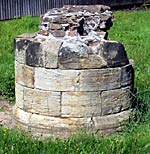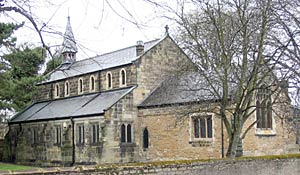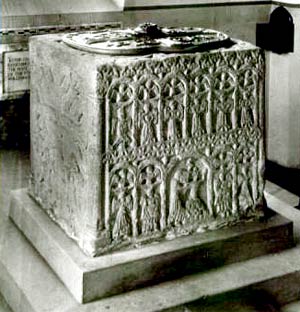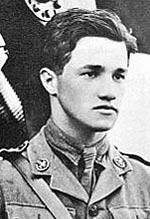< Previous | Contents | Next >
The Wonderful Font
LENTON. Nottingham, in making itself a splendid city, has swallowed up Lenton, but the village has kept its own identity, and has at least one treasure that brings the pilgrim here. Its ancient monastery, founded in the first years of the 12th century by William Peverel, rose proudly in the meadows where the little River Leen ran on its way to the Trent, and the monks would look up on one side to Peverel's castle on its high rock, and on the other to the green hills of Clifton. No man for miles around was so powerful as William Peverel. His priory was one of the richest, but it shared the fate of the religious houses seized by Henry the Eighth and its last prior was hanged with some of his monks.

Column base from Lenton Priory in 2004.
Sir William Babington was buried here in 1455 when he was 99; he was Chief Justice and Baron of the Exchequer. Of all the ancient splendour, only a few fragments remain. The bases of two Norman pillars are in a back garden in Old Church Street. In the Abbey Church close by is Norman carving on an altar step, and part of a medieval gravestone showing a chalice and a book by the stem of a cross is near the west doorway.

Chapel of St Anthony at Lenton Priory in 2008.

The Lenton font in the 1920s.
This small church, with great chestnut trees for company, is on the site of a chapel of St Anthony which was attached as a hospital to the priory. The chancel and the vestry are part of the 16th century church built for the people when the monastery was destroyed, but the nave was made new half a century ago, after being in ruins for forty years.
The remarkable relic of the priory is the font, which was found at the close of the 18th century when foundations for a house were being dug. Then it was used for a time as a garden ornament; now it is in the spacious parish church, full of years and honour. It is indeed a wonder. It is almost square, and its sides are so richly carved that it is famed as the finest Norman font in the Midlands, and one of the best in the kingdom. On one side is the Crucifixion with the two thieves; on another a floriated cross; on the third two rows of rich arcading with angels, and the Baptism in Jordan; while panels on the fourth side may represent the Ascension, the Resurrection, the Church of the Sepulchre, and the three Marys. This noble font is the chief possession of Lenton's 19th century church, which has a lofty pinnacled tower, and a beautiful oak screen with a canopy rising from the middle of its single span.
Here is remembered one of the famous heroes of the Great War; it is thrilling to see his Victoria Cross engraved on his brass, with his other medals in the four corners of the plate. This rich brass, with a border of oak leaves, is a memorial to Albert Ball, the Nottingham airman who fell in France in 1917, a youth of 20 who won the VC, the DSO three times, the French Legion of Honour, and the Russian Order of St George. There is a fine bronze of him in the grounds at Nottingham Castle, and Lenton has a group of eight almshouses in his memory. They are in a charming setting, and have an aeroplane as a weathervane. In them live the widows of the Lenton men who never came home again; their peace memorial stands in front of the garden.
At the back of the White Hart Inn are the barred rooms of the old Peverel Gaol, founded in 1113 for the imprisonment of debtors and left standing when the Court was abolished in the middle of last century. Other relics of the past are the mounting blocks at the front door of the inn.
The Bayard of the Skies

ALBERT BALL, whose name should be written in gold in the annals of heroism, was born at Lenton in 1896. He was only 20 when the Germans laid him to rest in the cemetery at Annoeullin, near Lille. In that short span of life he won the love of all who knew him, and in his career as an airman he reached the highest pinnacle of success. From early boyhood he had shown great interest in mechanics, and, although when the war came he immediately joined the colours as a private of the Sherwood Foresters, he was already looking to the skies, and was soon transferred to the Royal Flying Corps.
As a flying man young Albert Ball, fit in mind and body as a man can hope to be, found himself borne on wings of joy. "I always sing up in the clouds," he wrote. As a fighting man, though he hated killing ("I only scrap because it is my duty"), he showed remarkable skill, and brought down at least 47 enemy planes. His last flight was in May 1917, when, after bringing down two German planes, his own machine was brought down by anti-aircraft guns.
In his lifetime the highest honours were given him, but he remained unspoiled. At his death enemy and comrade alike paid tribute to his sterling qualities, and on his grave the Germans set a wooden cross, carved with a laurel wreath and the words, "He gave his life for the Fatherland." That was Captain Albert Ball, without fear and beyond reproach, the Bayard of the Skies, a youth with the divine spark shining bright within him.
